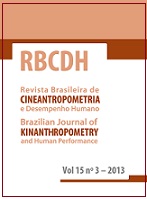Indicadores antropométricos de obesidade como preditores de pressão arterial elevada.
DOI:
https://doi.org/10.1590/1980-0037.2013v15n3p338Resumen
A pressão arterial elevada (PAE) é o principal fator de risco para mortalidade no mundo, porém poucos adolescentes conhecem os valores de sua pressão arterial. Em jovens, o sobrepeso é o principal determinante para PAE. O objetivo deste estudo foi avaliar a capacidade de indicadores antropométricos de obesidade como preditores de PAE em adolescentes. Realizou-se um estudo transversal com 1.142 adolescentes, de ambos os sexos, 14-19 anos, da cidade de Santa Maria, RS. Foram verificados os seguintes indicadores antropométricos: índice de massa corporal (IMC), circunferência da cintura (CC), razão cintura-estatura (RCE) e índice de adiposidade corporal (IAC). A PAE foi identificada quando acima dopercentil 95. Utilizou-se a análise das curvas Receiver Operating Characteristic (ROC) com intervalos de confiança de 95%, os pontos de corte com melhor acurácia foram identificados pelos valores de sensibilidade e especificidade. A prevalência de PAE foi de 23,6%, superior entre os rapazes(33,2%). Os maiores valores para área sob as curvas ROC foram: RCE (0,73;IC95%: 0,69-0,77) e IAC (0,71; IC95%: 0,67-0,75) para moças. Para os rapazes:IMC (0,64; IC95%: 0,60-0,68) e RCE (0,63; IC95%: 0,59-0,68). Os pontos de corte propostos para RCE (rapazes=0,44; moças=0,45) foram os que apresentaram maiores valores absolutos de sensibilidade e especificidade, ambos acima de 60%. Conclui-se que medidas antropométricas de adiposidade são válidas para identificação de PAE em adolescentes. Rapazes e moças com RCE ?0,44 e ?0,45, respectivamente, possuem alto risco de apresentar PAE.
Descargas
Publicado
Número
Sección
Licencia

Direitos Autorais para artigos publicados nesta revista são do autor, com direitos de primeira publicação para a revista. Em virtude da aparecerem nesta revista de acesso público, os artigos são de uso gratuito, com atribuições próprias, em aplicações educacionais e não-comerciais, desde que seja dada a atribuição. Esta obra foi licenciada com uma Licença Creative Commons Atribuição 4.0 Internacional - CC BY


